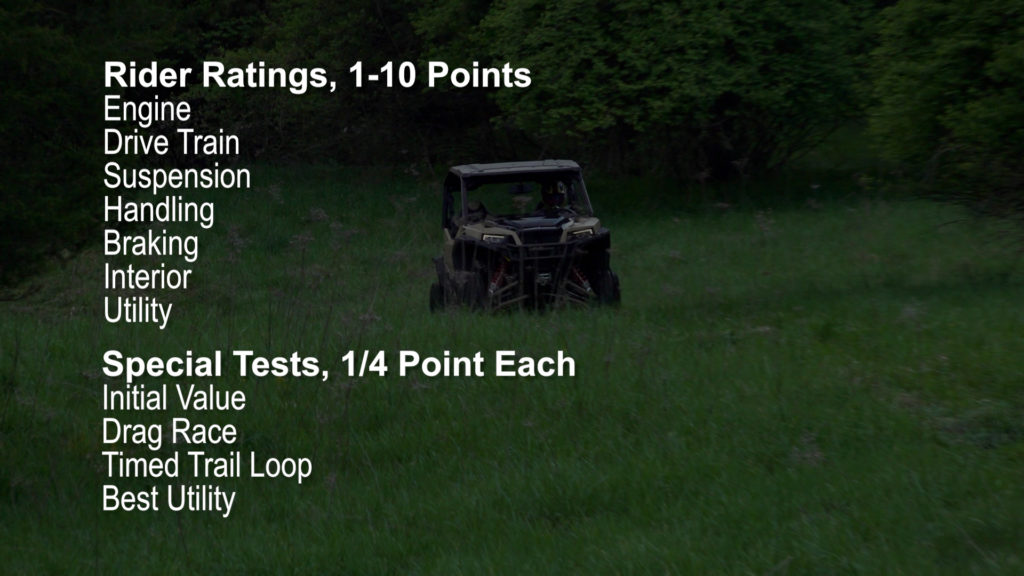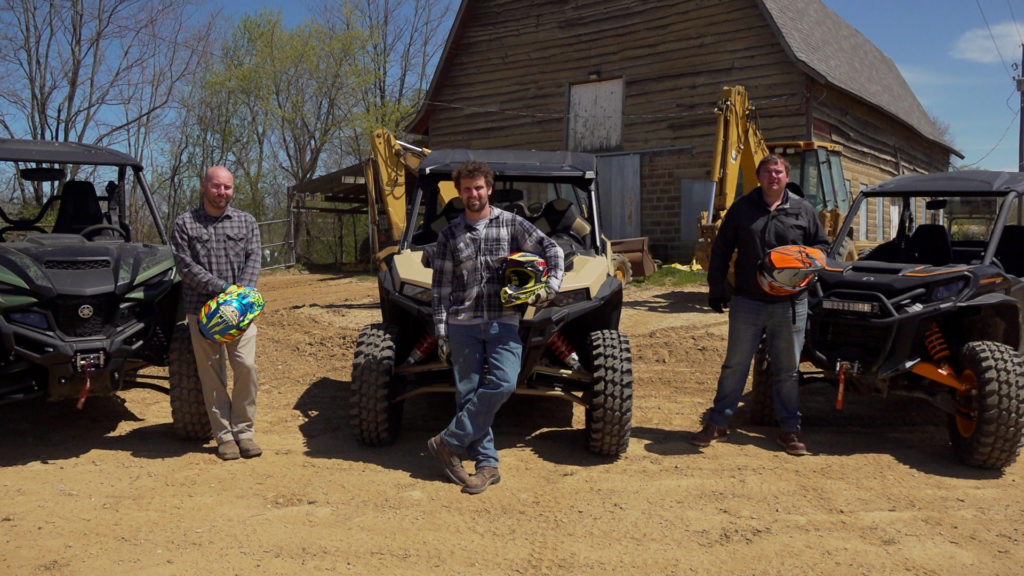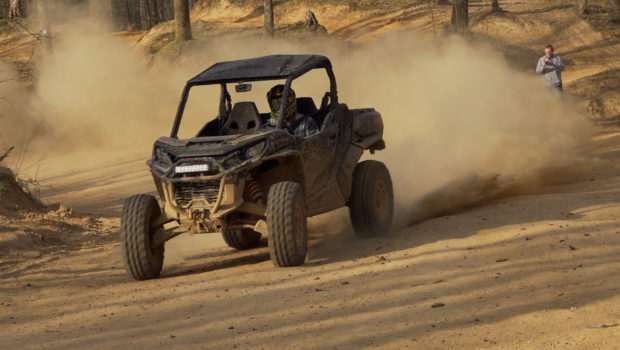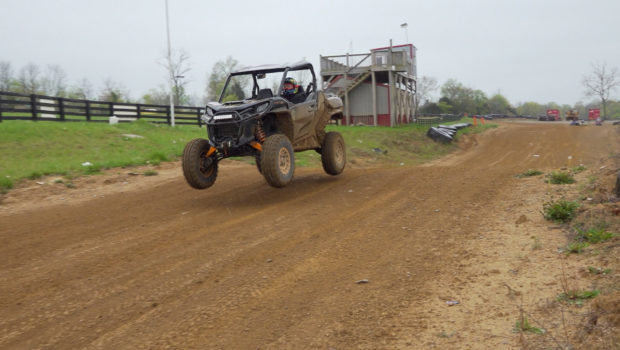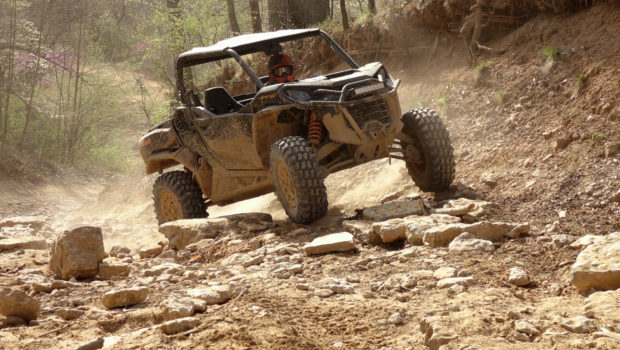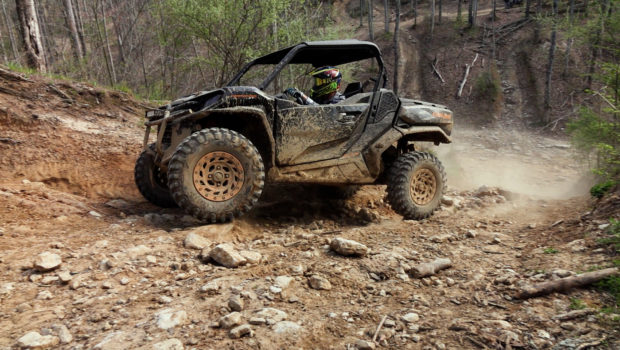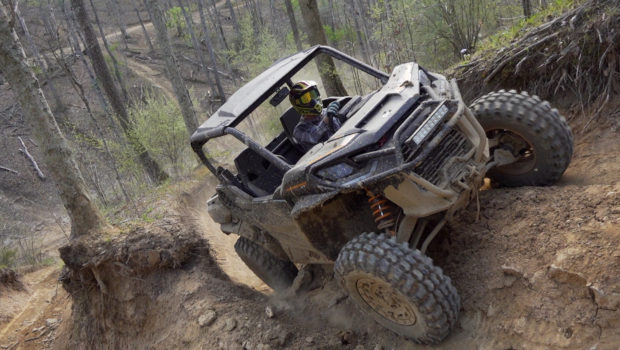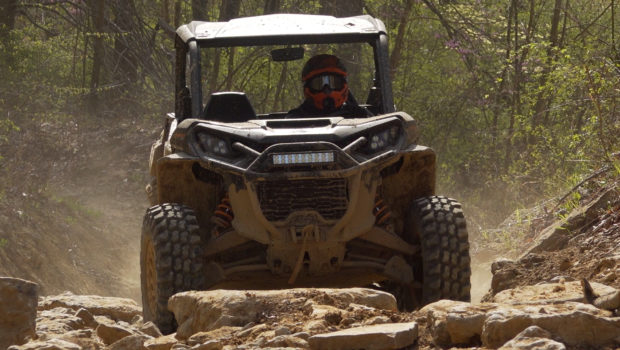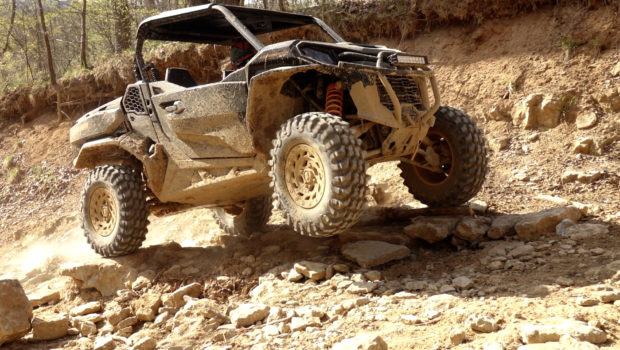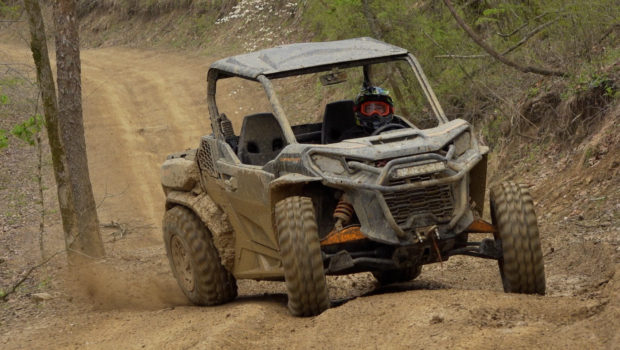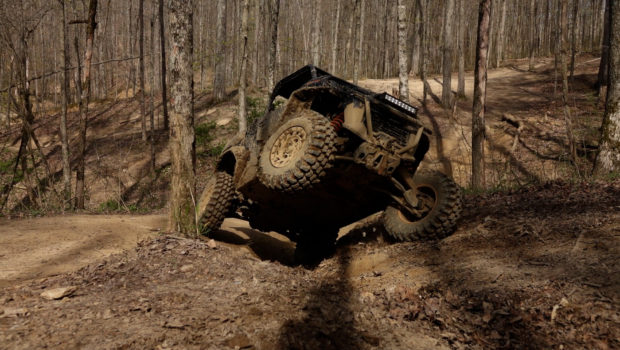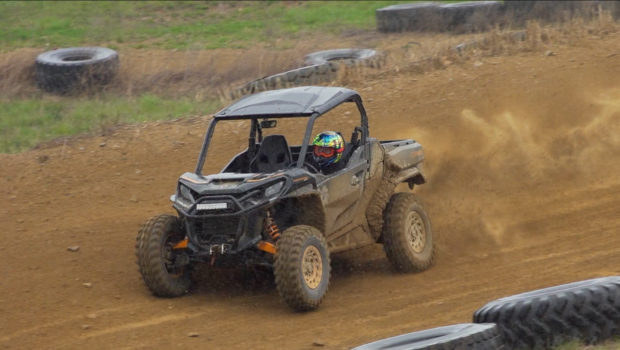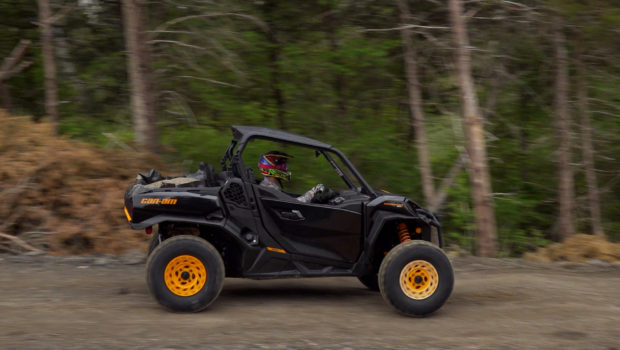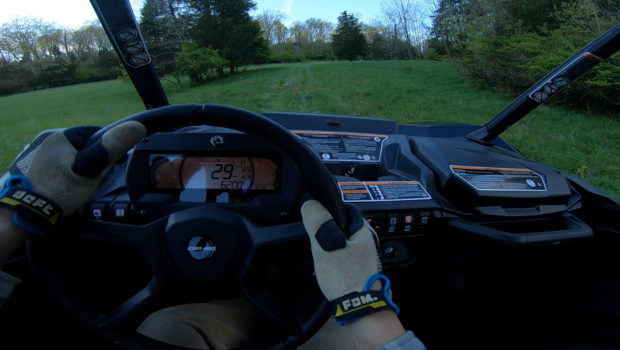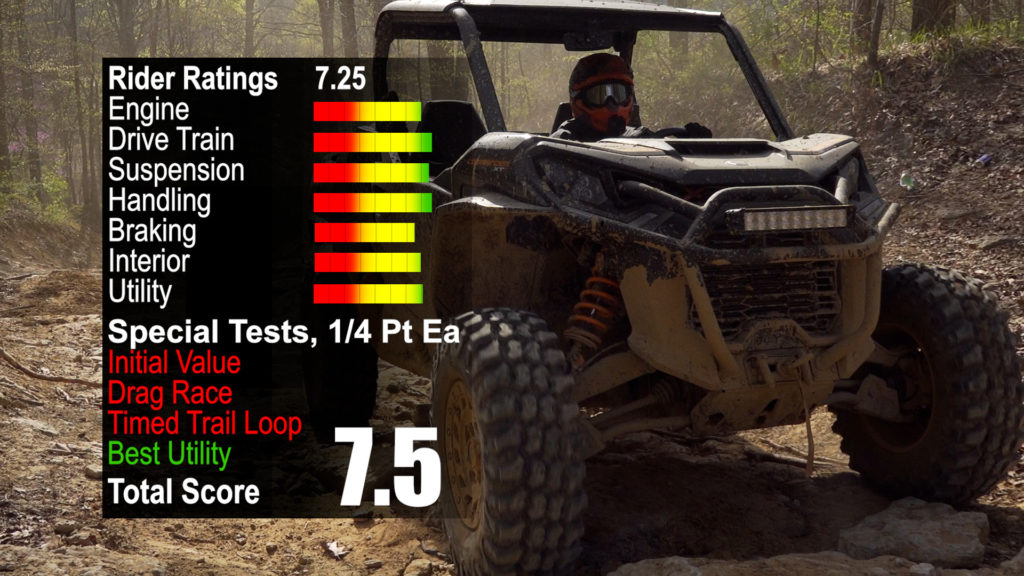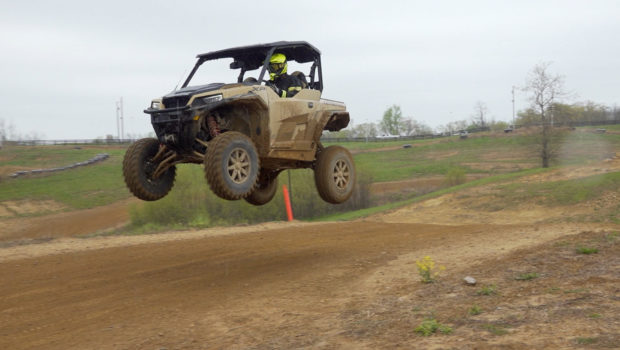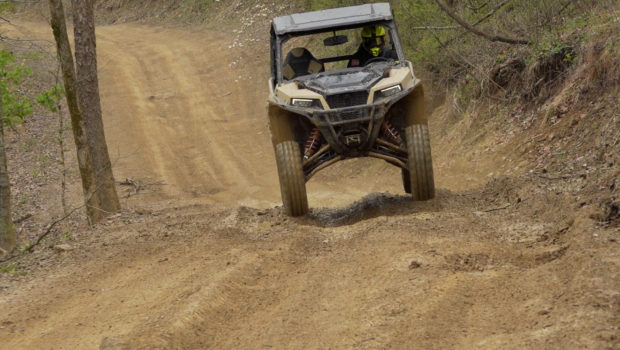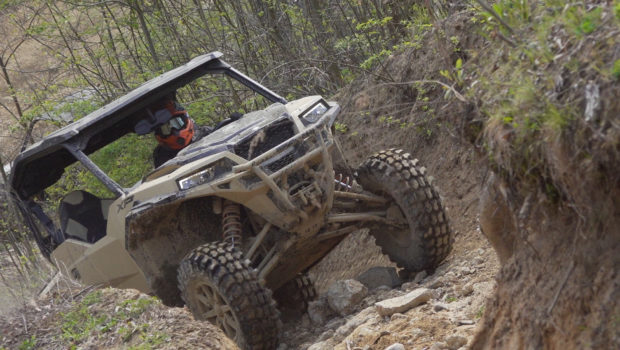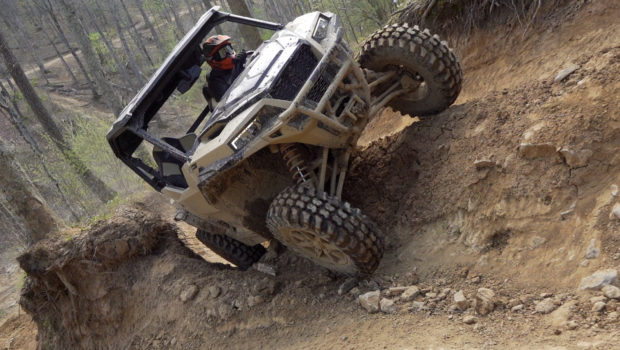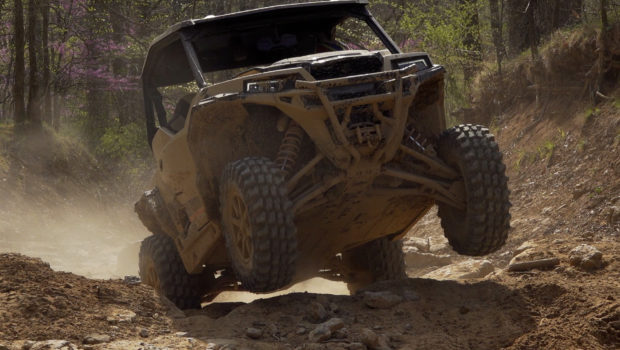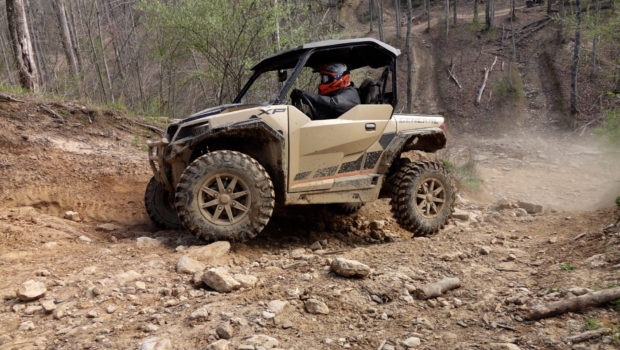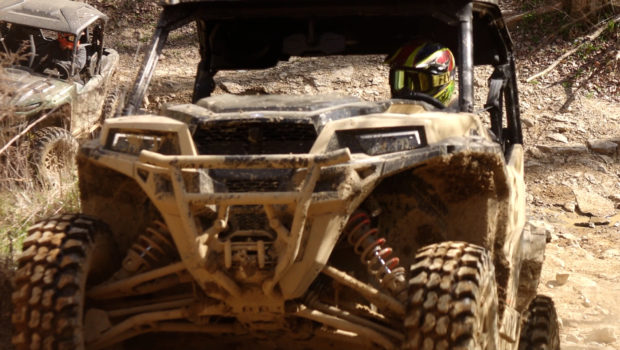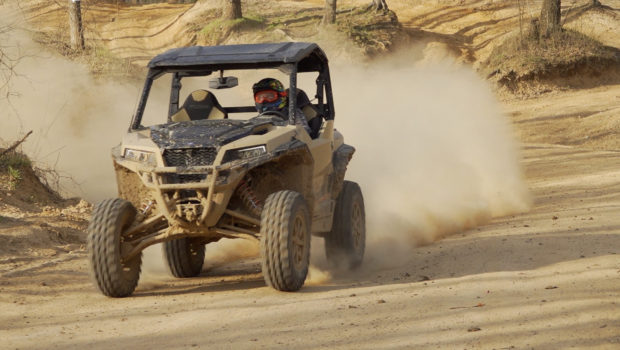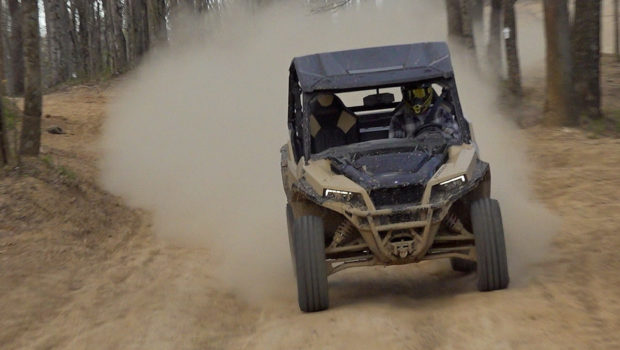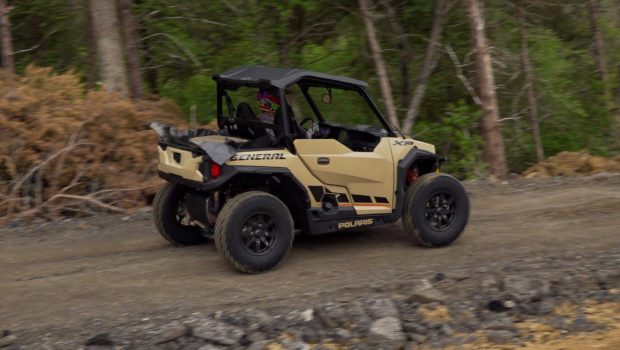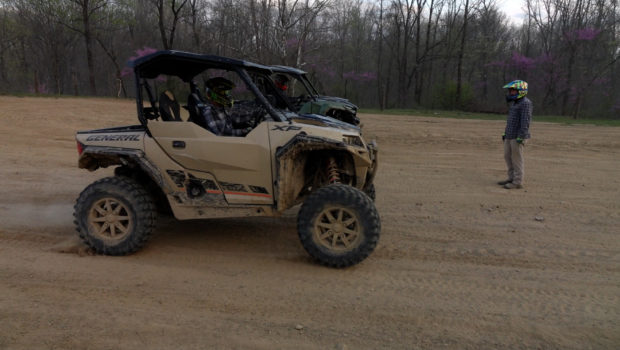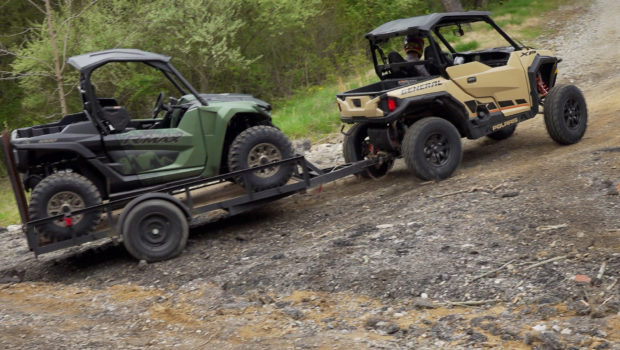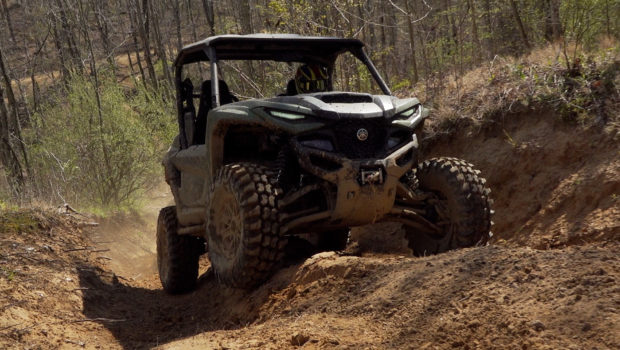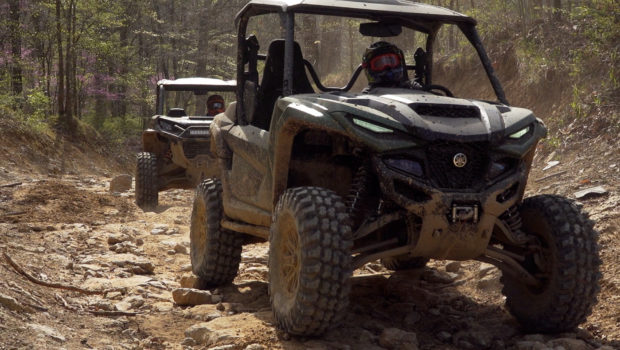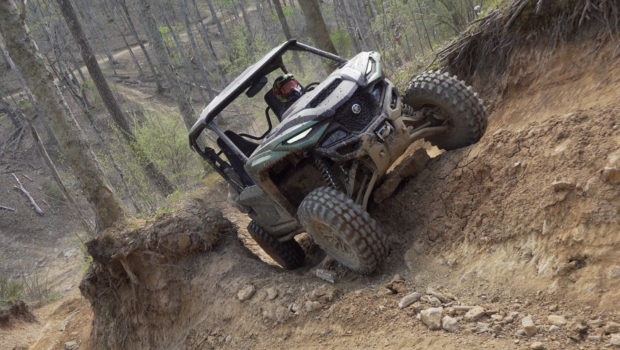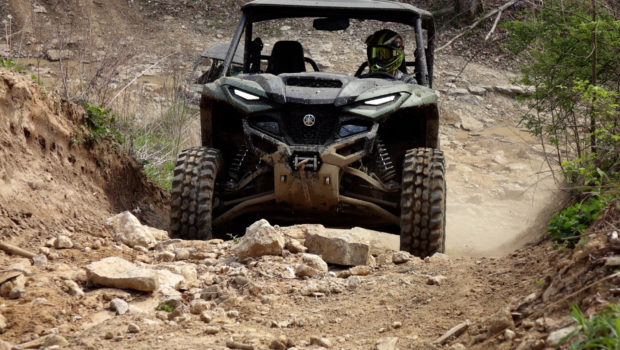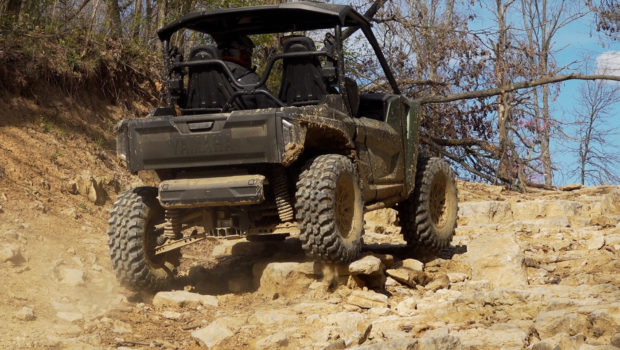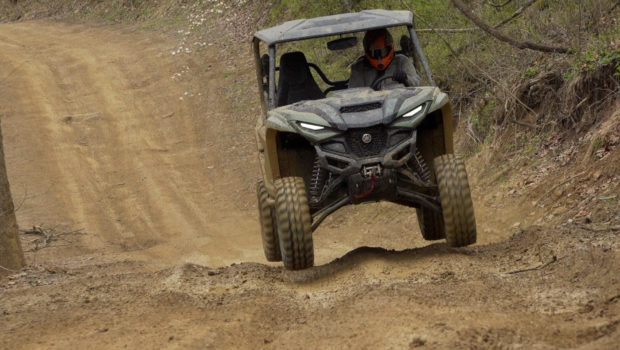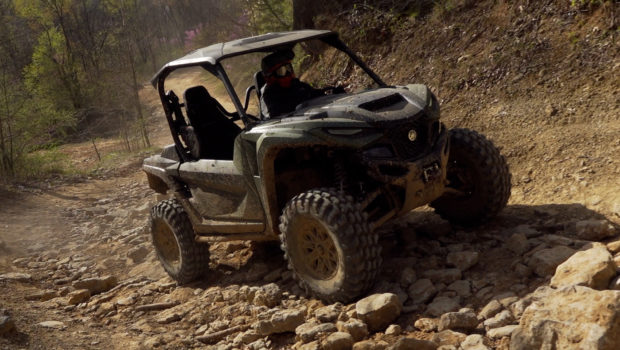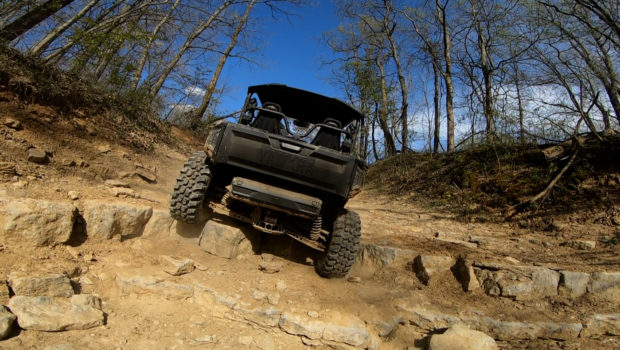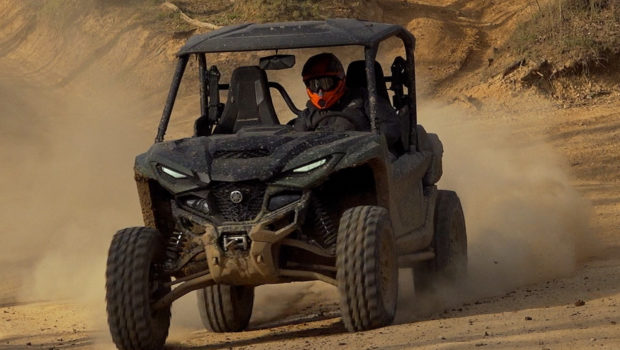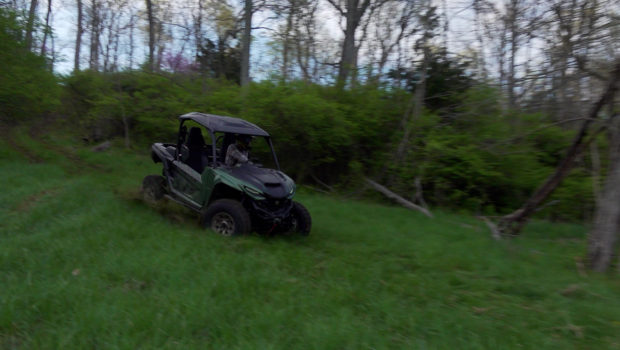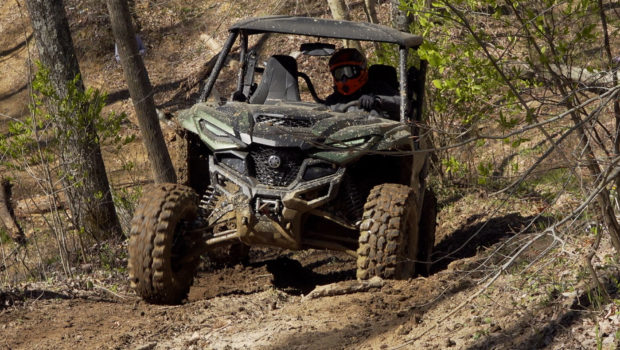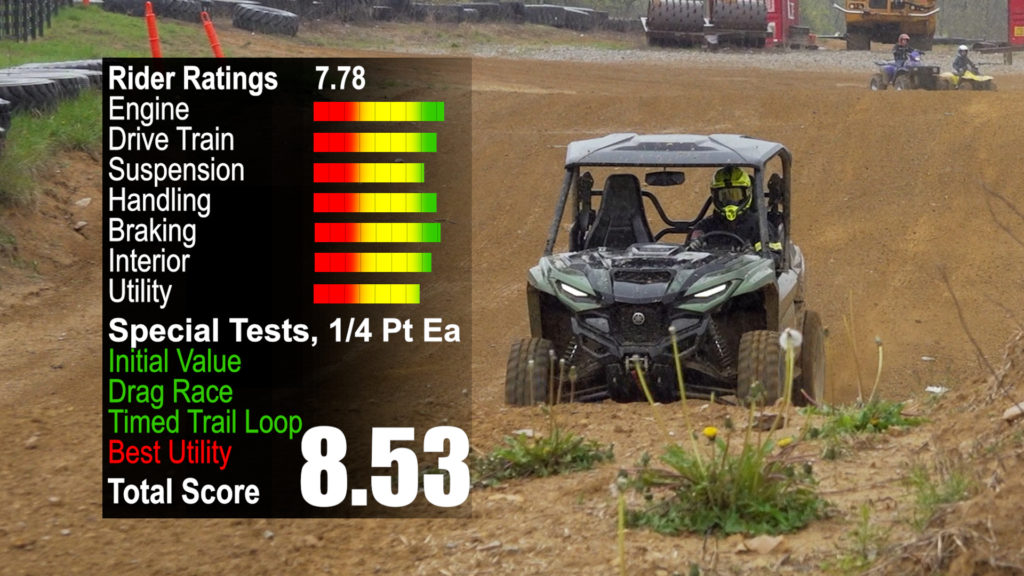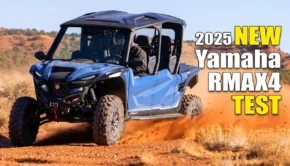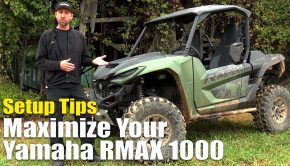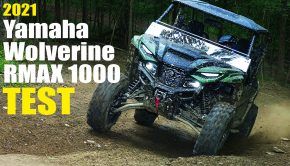Published on December 1st, 2021 | by Joe
2022 Sport Utility SXS Shootout: Yamaha RMAX 1000 vs Commander 1000R vs General XP 1000
With three new models released in the past three years, the 1000cc sport utility segment is the hottest in SXSes today. All are hard workers and capable performers on the trail, yet this class is hardly a clone war. Although they’re all 64” wide with 1000cc class engines, each of these machines provide a unique approach and experience that its manufacturer believes delivers the ultimate do-it-all SXS, providing three very good, yet distinctly different, machines.
The Contenders
With the Can-Am Commander released mid-2021, our shootout was filmed late model year 2021. While colors and trim package have changed slightly, there have been no significant updates for 2022 that would affect the baseline performance of the models we’re comparing. When choosing the trim packages to compare, we wanted to keep the MSRPs and features as close as possible among them. With that in mind, in 2022 pricing, we’ll be comparing the $25,299, base model, Polaris General XP1000 Deluxe, Yamaha’s second to the top-of-the-line Wolverine RMAX2 1000 XT-R at 23,899, and Can-Am’s top-of-the-line Commander 1000R XT-P retailing at $22,699.
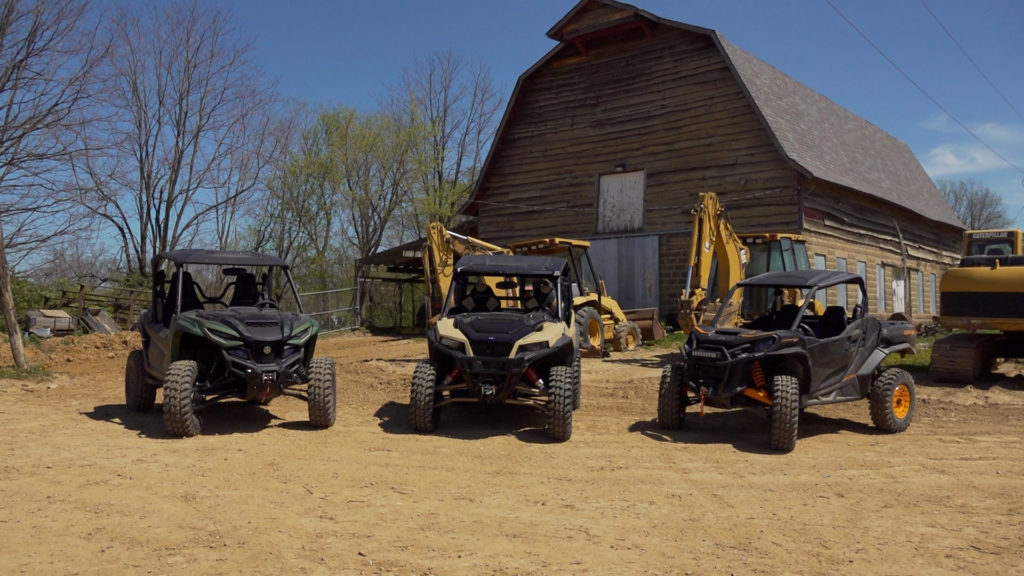
Pictures left to right, the Yamaha RMAX2 1000, Polaris General XP 1000 Deluxe and Can-Am Commander 1000R XT-P
Mechanical Breakdown
All of these machines use water-cooled, fuel-injected, twin-cylinder engines. Yamaha and Polaris both measure in at 999cc and utilize a parallel cylinder design. Can-Am’s Rotax engine is a v-twin design measuring in at 976cc. The Commander has a 12:1 compression ratio, 11.6:1 for the RMAX and 11:1 for the Polaris. The Commander and the General both produce 100hp with the RMAX producing 108hp.
Yamaha and Can-Am both offer multiple throttle modes to help maximize performance for different uses. The Commander offers two modes, Sport and ECO. The RMAX’ drive modes affect both throttle delivery and engine braking. It offers three modes: Sport, Trail, and Crawl. The Polaris General sees no need for such frills with a single throttle mode.
All of these machines feature fully automatic CVT transmissions with high and low ranges plus neutral and reverse. Can-Am and Polaris offer park in their transmissions. Polaris and Yamaha are outfitted with parking brakes. The Commander and General both rely on belt slippage on initial takeoff while the RMAX uses a primary clutch to regulate initial power delivery.
The RMAX can be run in two-wheel-drive, four-wheel-drive, and four-wheel-drive with front differential lock. To help prevent damaging sensitive turf, the General and Commander allow you to unlock the rear differentials. They also offer two and four-wheel drive options.
Unique to the Commander is the ability to unlock the rear differential while engaging any of its front differential settings. Useful for extra traction on sensitive ground, the Commander XT-P benefits from Can-Am’s computer-controlled, Smart-Lok front differential. Besides two-wheel drive, it offers three drive modes. The more reactive Trail mode and more predictive Trail Active mode are designed to work as limited slip front differentials locking in both front wheels when the front-end brakes traction, unlocking when traction improves. Smart-Lok also allows the front differential to be locked in full time with the push of a button.
In its all-wheel-drive setting, the Polaris operates in two-wheel-drive, locking in drive to both front wheels any time the rear tires spin marginally faster than the fronts.
All three machines feature steel chassis. The General XP features high-clearance dual-A-Arms and 14” of suspension travel at both ends. The Commander XT-P features high-clearance Dual A-Arms front and arched Torsional Trailing Arms rear with 14” of suspension travel at both ends. The RMAX features arched dual A-Arms front with 14.2” of suspension travel and dual A-Arms used out back with 16.9” of travel.
Front and rear suspension on the Can-Am and Polaris are outfitted with sway bars. The Yamaha uses a sway bar up front, but foregoes one out back for rear greater independent action. Yamaha and Can-Am both use Fox Podium QS3 shocks featuring compression damping with a soft, medium, and firm compression damping setting for quick, easy tuning. Polaris went with 16-way compression damping adjustable Walker Evans needle shocks allowing for a bit of fine-tuning. All of the shocks feature threaded preload adjustment.
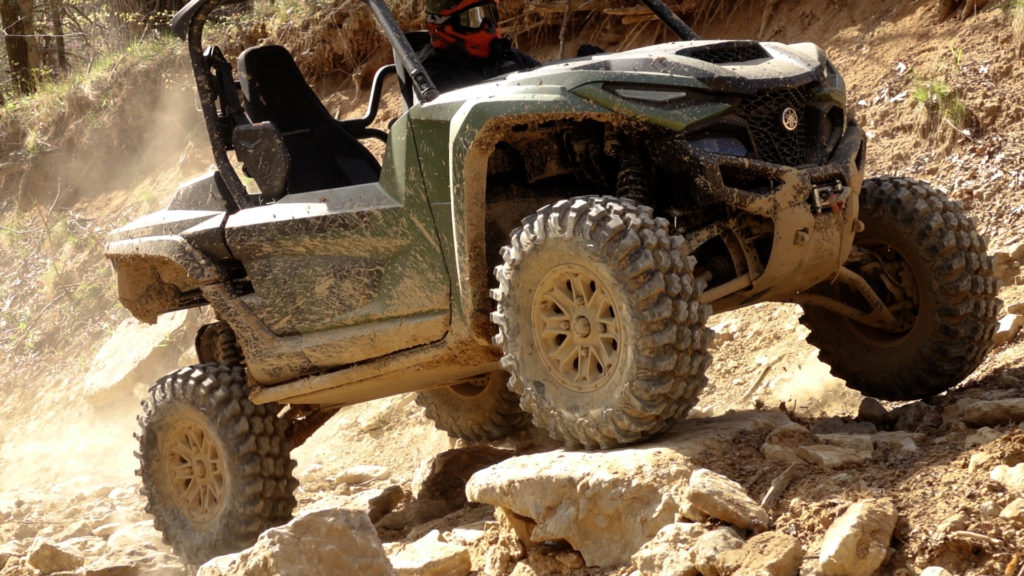
Planet SXS recommended Super Grip K9 XT tires to level the playing field in traction for our competitors. The XT is Super Grip’s second generation K9 tires. They feature 22% thicker sidewalls for improved stability and puncture resistance while their 8-ply radial construction provides a good balance of durability, weight, and ride quality.
All their machines roll on 30×10 in. tires offering a square tire setup from the factory. Yamaha used 14” wheels with Can-Am and Polaris used 15” wheels.
With all their SXSes coming outfitted with tires best suited for certain terrain, we felt it necessary to level the playing field in traction and tire performance to fairly evaluate these machines.
We contacted the tire experts at PlanetSXS.com looking for a solution. We wanted to outfit all three machines with stock size, identical tires offering great all-around performance, while also standing a good chance of surviving three days of intense driving.
Planet SXS recommended Super Grip K9 XT tires. The XT is Super Grip’s second generation K9 tires. They feature 22% thicker sidewalls for improved stability and puncture resistance while their 8-ply radial construction provides a good balance of durability, weight, and ride quality. 1” lugs provide good penetration in loose terrain, while the large tread blocks put maximum rubber on the ground for traction on hard surfaces. We installed their longer lasting standard compound. Super Grip also offers an intermediate compound for improved grip on slick rocks and loose terrain. Get more information or order your own set of Super Grip K9s XT tires at PlanetSXS.com.
Dimensionally, they’re all 64” wide, but differ greatly in other areas. The General has an 83” wheelbase; the RMAX, 86.7”; and the Commander, 90.6”. Ground clearances are close with 13.5” for the General and Commander and 13.8” for the RMAX. The Commander has an overall height of 74.5”, 77” for the General XP, and 77.8” for the RMAX.
All of these machines are stopped by four-wheel hydraulic disc brakes.
Examining utility capacities, all three machines are rated to carry 600 lb in their hydraulically assisted, dumping cargo beds. The Can-Am Commander has the largest bed capacity at 14,134 cubic inches plus there’s additional storage available under the easily removable bed sides. The General’s bed is 13,748 cubic inches and the Yamaha RMAX has 12.027 cubic inches All here have two-inch hitch receivers with the Can-Am and Yamaha rated to tow 2,000 lbs and the Polaris rated to tow 1,500 lbs.
Inside, all three machines offer dual cup holders. The Yamaha and Polaris offer passenger side glove boxes and storage boxes between the occupants. The Can-Am has two storage boxes mounted on top of the dash. Yamaha and Can-Am each offer a couple small storage trays, while the Polaris’ larger, in-dash storage trays are similar to what you find in their more purely work focused Ranger models.
All of these units feature half doors, slide adjustable driver’s seats, and tilt steering wheels. Instrument displays tilt with the steering on all three machines. Yamaha and Can-Am utilize fully digital displays with Polaris using a combination analog and digital display.
Scoring and Testing
For this shootout, our panel of drivers rated each machine’s performance on a scale of 1 to 10 in the categories of engine, drive train, suspension, handling, brakes, interior, and utility. The machines will also compete in four special tests: initial value, drag race, timed trail loop, and best utility. Each special test is worth an additional ¼ point each.
We’ll be presenting each SXS in the order it scored to make it easier to focus on each machine’s performance individually. However, we’d recommend purchasing based on your individual needs and the terrain you typically drive in.
Our shootout took place over three days. Day 1 was utility and timed trail loop comparisons. For our utility testing ,we pushed towing and hauling ratings to the max and beyond to see how well they worked. The timed loop took place on a virgin trail we created with lots of turns, long straights, plenty of ups, downs, and off cambers, plus bumps of various sizes. Day 2 was held at Haspin Acres Off-Road Park in Laurel, Indiana where the contenders took on everything from fire roads to rock crawling, mud, and Haspin’s drag strip. Finally, on day 3, the cameras barely came out of the bag as our drivers ripped the perimeter trail at Dirty Turtle Off-Road Park in Bedford, Ky and spent some time on their short course race track, better mimicking the whooped-out conditions found out West.
Our Drivers
For this shootout, we acquired the services of 34-year-old, veteran test driver, former pro ATV racer, longtime SXS enthusiast, farmer, and mechanical engineer, Aaron Meyer; 34-year-old veteran test driver, Rob Frede; and making his first appearance driving for UTV on Demand, former dirt bike racer and longtime sport SXS enthusiast, 33-year-old Eric Jones.
The Shootout
Can-Am Commander 1000R XT-P
The Commander 1000R XT-P is the cruiser of the sport utility segment. It’s probably the least fatiguing machine to ride in, making it ideal for the longest days on the trail as long as you fit in it comfortably. It’s also arguably the hardest worker in the class, making it ideal for those who’d rather forego the cabin and haul camp along with them.
Renowned for their engine performance and based on the happy-to-rev Maverick Sport, it’s a little surprising when Can-Am has the mellowest engine of the bunch . Low-end power is good, doing well at getting the Commander rolling with authority, or towing a heavy load. Mid-range power is potent enough to carry a slide through corners.
Our sport-oriented test crew unanimously wanted more revs from the Rotax, rating its engine third in top-end power. The CVT is seemingly tuned to ride the peak torque curve rather than the peak horsepower curve. This makes upper midrange power seem a bit less impressive and upper RPMs feel out of reach. This was most apparent on long climbs where the Commander would torque its way up, unwilling to backshift and rip like the others. Still, a 70+ MPH top speed makes the Commander a capable high-speed cruiser on fire roads or when the trail opens up.
An aftermarket clutch kit should allow the Rotax 1000R engine to access its upper midrange and top-end power, while making the CVT feel a little more responsive at speed or under load. However, it must be noted that the Can-Am’s clutching greatly contributes to it being noticeably the quietest on test both inside and out, making conversation and Mother Nature easier to enjoy.
Smooth power and a well-shaped gas pedal allow the Commander to score high on driveability with little need to rely on its throttle mode switch in technical or work situations. Overall, our lead foot test panel unanimously wanted revs more than a quiet easygoing engine, rating the Commander’s engine third.
The Commander has four front differential settings to choose from with or without the rear differential locked. Driver opinion was all over the place. Rob went with the flow and felt all three drivetrains were equally capable of carrying him up, or through, whatever he encountered. Aaron rated the Commander’s drivetrain best, praising it for the confidence it inspired at speed, in technical situations, and for work. Eric rated it third, primarily due to the fact that he spent more time figuring out which Smart-Lok setting to use. He also struggled a couple times in muddy, rutted corners even with the front differential locked, although this may have had more to do with the longer wheelbase making it more difficult to track in the ruts.
It doesn’t make sense to those of us who prefer the ability to finetune our machine’s performance that the Can-Am didn’t win drivetrain performance, but when one driver craves simplicity over another’s ability to more selectively choose their four-wheel drive settings, the Can-Am scores third in drivetrain performance.
If you’d prefer a simpler, more streamlined drive system with your Can-Am, the Commander XT model comes with Can-Am’s traditional, hydraulically controlled, Viscco-Lok QE auto locking front differential. It foregoes manual front differential lock and dual trail modes, while maintaining the ability to unlock the rear differential. We’ve found Visco-Lok QE to be pretty darn effective on the Maverick Sport.
The Commander comes into its own in suspension performance. Small bumps are well absorbed, while not quite as plush as the Polaris. Large square edged bumps were most pleasant in the Can-Am. The front end would bottom a little easier than the Yamaha, but the back end stayed a bit more composed rebounding off the bottom. Whether its shocks or the longer wheelbase and lower seating position prevents you from being shaken up as much, the Can-Am feels like it outperforms the Polaris in uneven bumps.
When the trail gets whooped-out, the commander’s rear shocks will start finding the limits of their travel and kick a bit, forcing you to back off, although its longer wheelbase and rear sway seemed to do a little better job of keeping the back end in line compared to the Yamaha. Jumping is similar to whoops. The back end of the Can-Am tends to get light, but stays behind you where it belongs, unless you start sending it like a pure sport car. Erick rated the Commander XT-P’s suspension first. Aaron and Rob rated it second, giving it a strong second, overall, in suspension.
Longer, lower, and dual swaybar equipped, the Commander feels the most stable in corners, on sidehills, and makes it a predictable feeling slider. Steering precision is good on the Commander, but the longer wheelbase hurts it a bit in some rutted corners and in tighter terrain where agility is key.
There was a little increase in steering effort with the front differential lock engaged that’s to be expected. Driving aggressively into corners at speed, there was a bit more negative feedback through the steering than the others, even without the front differential locked in four or two-wheel-drive. This is due to Can-Am’s greater reduction in power steering assistance at higher speeds, which isn’t as noticeable with the more rounded, less aggressive OEM tires. This resulted in a 3rd place in power steering performance, although it does remain very controllable entering turns at speed and works brilliantly everywhere else.
With the longest wheelbase, the Commander is the second tightest turning machine in the shootout, although, its maneuverability is hampered by pivoting around objects or turning around in the middle of the trail. The long, low layout of the Commander helps it score highest in high-speed stability on fast, typically less whooped-out trails in our area. It also makes it feel more planted than the General on steep climbs and descents. Erick felt the Commander delivered sport SXS handling tying the Commander’s handling for first with Polaris. Aaron tied its handling second with Polaris. Rob rated it second, resulting in a 3rd for the Commander in handling.
The Commander’s brakes were good and didn’t seem to hold the machine back when it came to aggressive driving. Although all of our drivers agreed the General and RMAX offered a bit more braking power and slightly better feel, Eric noted a softer feeling at the pedal coming from the Commander.
With a cockpit virtually identical to the Maverick Sport, the floor sides are higher with the floor and seating position lower, making ingress and egress a bit harder on the Commander. Despite high praise for the Maverick sport’s interior, the purely sport inspired interior design is slightly lacking in attention to detail in the sport utility segment. The rattle free, high-quality half doors curve outward providing good shoulder and arm room. Aaron and Eric both rated the Can-Am highest in interior comfort, while 6’3” Rob rated it third due to his right knee resting against the DESS key mount causing discomfort. Try it on before you buy it. Chances are you’ll be very comfortable. Control operation on the Can-Am is hampered by a steering column that makes the wheel feel more flexy than the competition. The same holds true for the shifter and center console.
Heat mitigation inside the cockpit scores equally well on all three machines with the Commander easily scoring the highest on interior sound levels; it’s quiet! Fender design and the low sitting position keep the Can-Am’s occupants best protected from flying mud and debris, although the lower sitting position results in the most restrictive site lines in the class. If you want a seemingly pure sport cockpit on your sport utility SXS, the Commander won’t disappoint. However, next to the other two, it’s not quite as refined.
When loaded down to the max for work, the Can-Am’s high torque engine seems more impressive next to the others. Its ultra-versatile drivetrain is also best suited for getting work done. The shocks and long wheelbase do better distributing a load, allowing the Commander to excel over the others in suspension and handling while loaded. In addition to the two in cabin storage boxes atop the dash and two small storage trays on the center dash, the Can-Am has the most available storage thanks in great part to its bed and bedside storage. The bed is a bit on the high side, but its well-placed hinges make hauling and dumping big loads easier. Despite being the most challenging to get in and out of, and with the most restrictive sightlines, it’s not perfect, but it’s good enough to win best utility.
Besides winning best utility in our special tests, the Commander took third in drag racing by a little more than a half car length. It did well off the line, but clutching for lower RPM operation seemed to hold it back a bit. It wound up second fastest in our timed, wooded loop, battling back and forth with the winner over its three runs with a final time of 3:46:53.
In our opinion, in 2021, the Commander 1000R XT-P would have won best initial value. It offers a winch, roof, and rearview mirror like the others. It also offers more drivetrain settings, two throttle positions, and we value the survivability of beadlock wheels over interior floor lighting and a GPS. There are phone apps or other devices that can provide trail maps. For 2022, the competition changed things up a bit giving the Commander a close second in initial value.
The Commander scored 3rd in rider ratings at 7.25 plus a ¼ point for winning best utility for a total score of 7.5 points.
The Polaris General XP 1000
There’s no weakness in the General’s power delivery from idle through the top-end. It starts pulling hard off the bottom and just keeps building power seamlessly. It scored 8s in low-end, midrange, and top-end power. Aaron felt this made the General deceptively quick. Our riders tied it with Yamaha in low-end power, and found it faster than the Commander throughout the RPM range. It’s happy torquing around, or will rip on demand if the terrain or the gas pedal demands it. The CVT is well calibrated, snappy, and responsive throughout the RPM range up to its top speed of around 68 MPH.
With work and technical trail riding in mind, our drivers all wanted a little more engine braking from the General. Although its broad, smooth power, good clutching, simple drivetrain design, and, perhaps, most ergonomically correct gas pedal of the bunch allow the General XP to score highest in driveability, in spite of not having any fancy throttle modes like the others.
Eric noted that the Polaris was his personal favorite engine on test, although all of our drivers scored it second.
Simplicity won out in this shootout when it came to drivetrain. Polaris’ three options of one rear wheel, two-wheel drive, and all-wheel drive, with a knob allowing you to switch between them, the General tied for first in four-wheel-drive engagement.
We know there are drivers out there that will defend manually lockable front differentials to the end and for good reason. But, with Rob feeling all three machines’ drivetrains performed equally, Aaron preferring the added options of the Can-Am, and Eric rating the Polaris all-wheel-drive engagement and effectiveness so enthusiastically, the General XP wins drivetrain performance.
In its defense, none of our drivers complained about a lack of traction with the Polaris. In all-wheel-drive, none of our drivers felt the steering stiffened up like the Commander and RMAX with their front differentials locked.
Manufacturers are trending toward dumbing things down a bit due to many SXS enthusiasts’ lack of off-road experience with simple or computer controlled suspension, drive modes, and special keys to limit power for noobs. So, a drivetrain that simply works well and requires less thought is probably a winner for many drivers
Polaris nailed the suspension on the General. The 15-way compression adjustable Walker Evans’ shocks allow finer tuning. Our drivers also felt they offered the widest range of adjustment from plush to firm. This helped the General’s suspension score highest over small bumps while offering sport SXS worthy performance over small whoops and chop. Great weight balance and shocks with internally well-tuned rebound damping make the General’s suspension rate highest for jumping. It flies straight and level off a good jump, face landing plush on the downside of respectable sized leaps.
G-outs with square edged bottoms made the Polaris blow through its front travel and bottom harshly more than the others, making it score lowest on large bumps. Also, the shortest wheelbase, sway bars, higher seating position than the Can-Am, and wobbly seats made it score lowest in uneven bumps. Even still, it is a capable crawler. When your shocks work well from roots to whoops, it’s hard not to finish first in suspension. Erick rated it second behind the well-rounded Can-Am, and Aaron and Rob rated the General’s suspension best.
The General’s handling is well matched to its responsive, sporty engine and suspension. Our drivers rated it highest for steering accuracy and power steering, which kept steering light and unwanted feedback filtered out at all speeds.
The Polaris had a little more weight transfer heading into corners, which loaded the outside front tire aiding steering accuracy. Coupled with the taller seat height, it ties for a very stable second place in cornering and sidehill stability. Despite having the shortest wheelbase in the class, the General takes second in maneuverability, with one driver feeling it had the widest turning radius in the class Top-rated suspension and steering allow the General XP to take a respectable second in high-speed stability in spite of its shorter wheelbase.
The shorter wheelbase and seat wobble netted the General a third place in climbing and descending. It made every climb the others tackled; it simply wasn’t as confidence inspiring doing it. Aaron tied the General’s handling for second with the Commander. Rob tied it for first with the RMAX. Eric tied it with the Commander for first. By .06 of a point, the very sporty General squeaked out a first place in handling.
The General tied for first place in brakes in power, feel, and balance front to rear, offering performance on par with the RZR.
Entering and exiting the cabin, the General tied for first for ingress and egress, although big Rob rated it highest with its higher seating and unobstructed entrance. Spacious, well laid out, and functional, the cockpit isn’t quite as refined as the RMAX giving it second in interior design.
The General takes last in interior comfort for a few reasons such as seats that sit higher like the Yamaha, which we can deal with, but wobble too much. The doors rattle, while its competitiors’ doors don’t. The side hand holds aren’t as functional as a grab bar in front of the passenger, especially with suspension that begs to be pushed through rough, high-speed sections.
High quality switches, knobs, a rigid feeling steering wheel, gear selector and beautifully ergonomically designed gas and brake pedals give the General a solid second in control operation. Tying with the others for interior heat mitigation, the General scored 1.67 points behind the ultra-quiet Can-Am in interior sound level. Riding high in the cockpit, a good fender design helps protect occupants from flying debris resulting in a second place score in mud/debris protection. Higher seats and the flattest hood help make the General the easiest machine to see out of. Rob rated the General’s interior best. Aaron rated it second and Eric rated it third, giving its interior second overall.
For our utility testing, the General’s engine tied for first with the RMAX, easily pulling a heavy load at any speed. It’s shorter wheelbase resulted in the worst balance of the three when loaded or towing, causing more front-end push than the others. This resulted in a third place in both suspension performance and handling while loaded.
There are multiple open trays inside the cockpit, similar to those found in Polaris’ work focused Ranger models, in addition to a glove box in front of the passenger, and another box in the center console. Available storage tied for second behind the Can-Am, although the Polaris is rated to tow 500 LBS less than the others. In spite of a well-balanced dumping bed, suspension and handling made storage ease of use a bit more difficult to take advantage of than on the Can-Am. Although we felt it finished third in utility performance,
tying with the Yamaha in ingress and egress, having the best sight lines in the shootout, and having the ability to unlock the rear differential for use on sensitive turf definitely add to the General’s desirability as a work vehicle.
In our bonus special tests, the General took 3rd in utility ratings. It took a very close second in drag racing. In our timed woods loop, the General finished with a time of 3:47:37, 0:84 off the pace of the Can-Am. If our test look had been a whooped-out desert trail, the General could have won in lap times, but the shorter wheelbase and wobbly driver’s seat compromised confidence a bit on abrupt downhills, tall or short. Additionally, there were a couple of big hits that forced you to back off the gas a bit more in the Polaris resulting in a 3rd in lap times.
For 2022, the General XP 1000 Deluxe continues to come with a gnarly front bumper, winch, roof and rear view mirror like the others. Interior LED lighting and a Rockford Fosgate Stereo system are nice touches missing from the Commander, but with no beadlock wheels, or Ride Command infotainment system/GPS added as an accessory in our General, we feel the XP 1000 Deluxe is a little sparsely appointed for its $25,299 price tag, keeping it from winning best initial value. Polaris offers higher trim packages with Ride Command and other add-ons, but the price just goes up from there. Still, if you’re in the market for a sport utility SXS that can pound whoops and get a little air like a sport SXS, the General’s value goes way up.
Taking a competitive second in engine, winning in drivetrain, suspension, and handling, tying for first in brakes, second in interior, and 3rd in utility performance, the Polaris scored second in rider ratings with 7.76 points. Our riders liked it enough to take second in points without claiming any special test wins, a testament to its overall performance.
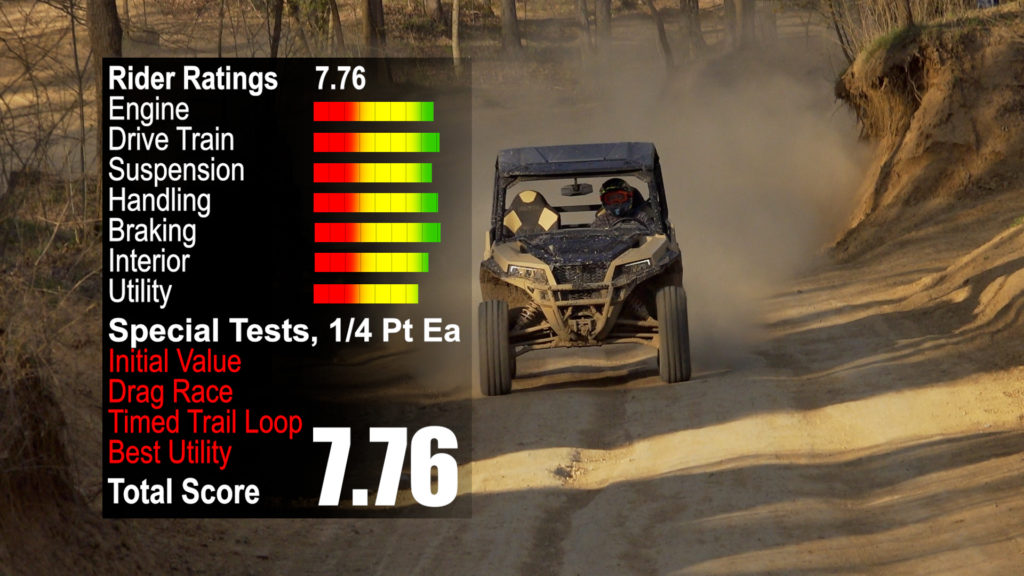
Polaris General XP 1000 Deluxe scoring.
v
Yamaha RMAX2 1000 XT-R
It’s clear that Yamaha was looking to set the standard in the engine department when developing the RMAX. It tied the Polaris for first in low-end power. Initial clutch engagement is automotive like, due to the CVT’s primary clutch handling engagement rather than a belt, which can feel a little grabby. However, the Yamaha is dependent on its trail or crawl drive modes to smooth out unwanted gas pedal inputs as the pedal’s shape makes it harder to modulate, which is noticeable in sport mode.
Midrange and top-end power are both class leading with the gap in performance slowly increasing as RPMs climb. CVT responsiveness rated at the top of the class. It’s well-tuned quickly, getting you into the best part of the powerband, gassing it out of corners or back shifting to turn more RPMs on long, steep climbs.
The RMAX Drive modes deliver the ideal type of power for every type of driving, but our drivers scored it second in driveability, because the gas pedal’s design required you to use them to modulate the throttle at low speeds in rough terrain. Engine braking rated highest on the Yamaha with its lighter engine braking in sport mode and more powerful engine braking in trail and crawl modes. The RMAX engine scored first overall, one of the things our drivers agreed on unanimously.
Yamaha scored above the Can-Am in drivetrain performance for being more simple, yet effective. Eric praised the combination of front differential lock with the throttle’s crawl mode engaged, which made the RMAX his favorite to rock crawl or climb gnarly hills with. Aaron praised its simple, effective drivetrain for sport or utility use, but it was the only one on test lacking the ability to unlock the rear differential, so you have to be more careful with the RMAX on sensitive turf. Aaron and Eric rated its drivetrain second, while Rob tied it for first with the others, yielding a second overall in drivetrain performance.
While quite forgiving over small bumps, the RMAX didn’t quite filter out the micro terrain as well as the others. The RMAX front suspension bottomed less harshly than the others on large square-edged hits with the back end taking it in stride, but small, abrupt g-outs that load the rear suspension can make the rear end get a little light keeping the Yamaha in second over large bumps.
The RMAX is an explorer and rock crawler’s dream. The chunkier the terrain, the more the Yamaha stands out. The lack of a rear sway bar and nearly 3” more rear suspension travel than the others, allows the RMAX rear suspension to completely independently fill in holes and roll over impressively large obstacles. Both back tires track with the ground more effectively than the competition, doing better at maintaining traction while delivering a smooth level ride for the occupants. Throw the Drive mode in crawl mode, and the RMAX is a virtual trials machine. The Commander took a strong second behind the RMAX in uneven bumps, much in part to its lower sitting position. The RMAX takes first in uneven bumps, because its chassis and suspension works best there.
As speeds pick up and acceleration and braking bumps turn into small whoops, all of our riders felt they needed to back off more often in the RMAX. No rear sway bar and compliant suspension results in a back end that tends to load up and deflect a little more than the Can-Am and far more than the Polaris. We wound up adding 10mm of spring preload to the rear shocks and switching between the medium and firm setting on the rear shock’s compression damping. The back end remained light and floaty on whooped-out sections, but deflected noticeably less with these settings although detracted from small bump compliance. Our firmed up settings allowed the RMAX to fly straighter off jumps, although it doesn’t fly as straight and level as the General. Erick was wishing the rear shocks on the XT-R offered rebound damping adjustment to settle things down without firming up the ride. Having the ability to individually tune low and high-speed compression damping on the new RMAX Sport model should certainly be a benefit in high-speed chop, but the RMAX XT-R’s suspension takes third in whoops and jumps.
Taking second in adjustability, we were able to affect changes to improve suspension performance as desired. Aaron tried the RMAX suspension with the Commander for second. Erick and Rob both rated it third. While it was the dream in rough, technical terrain, the RMAX suspension rated 3rd overall.
Although its seating is higher than the Can-Am and is the only machine without a rear sway bar, the RMAX ties for second in cornering/sidehill stability with the General, feeling well planted. It takes second in steering precision and power steering with Eric wishing for a little less steering assistance at higher speeds even with the aggressive Super Grip K9 tires. The RMAX was rated the most maneuverable, confirmed by having the tightest turning radius on test, all measured with the rear differential locked.
All of our drivers agreed the rear suspension had them backing off the gas sooner in the RMAX any time high-speed met up with rough terrain resulting in a third place score in high-speed stability by a full point. On the flip side, it scored number one in climbing and descending by a full point.
Aaron rated the RMAX number one for handling. Rob tied it for first with the General, with Eric rating it second. However, the numbers were close enough among the drivers that the RMAX took second in handling to the General by a thin .06 of a point.
Braking performance is easily up to the task of slowing the RMAX tying with the General among our riders for the win in braking power, feel, balance, and total score.
Ingress and egress from the cabin was easy tying with the General, although Rob felt the RMAX’ shoulder bolsters were a bit intrusive. The modern, spacious layout of the RMAX interior let it score highest on interior design with its removable Adventure Pro Infotainment system/GPS tablet located between the occupants on the dash. The doors close tightly and don’t rattle.
Eric felt the seats set up too straight, and lacked bolstering on the front, making him feel less planted in the cockpit over rough terrain. Although, the seats feel solidly attached to the cockpit unlike the General. Soft touch points for your knees, soft touch steering wheel, and adjustable passenger grab handle allowed the RMAX to tie for first in interior comfort with the Commander. The steering wheel, switches, and gear selector all feel robust, and automotive quality resulted in a first in control operation, although the gas pedal’s shape isn’t quite on par with the others. Engine management scores evenly with the others with the RMAX tying for second in interior noise with the General. Sight lines out of the cockpit are rated second best due to the raised sides of the hood. Eric praised the slightly lower upper door lines aiding visibility of the front tires, although the lower door lines, higher seating, and more exposed front tires resulted in the RMAX scoring third in protection from flying mud and debris. Aaron and Eric rated the Wolverine’s interior first, with Rob rating it second giving the Yamaha’s interior first overall.
For utility use, the RMAX engine shared the top spot with the Polaris. The shock settings and second longest wheelbase in the class allowed the Yamaha to take a respectable second in suspension and handling while loaded. Available storage tied with the Polaris for second. The RMAX has similar passenger side glove and center storage boxes, but lacks the large, utilitarian storage trays found in the General’s cockpit. It makes up for it with 500 LBS more towing capacity, rated to tow a full ton like the Commander.
With the dump bed’s hinges located further toward the rear, it is much harder to dump a 600lb load out of the RMAX than the other two, giving it third in storage ease of use. However, the bed seemed a bit lower than the Commander’s and could be easier to load and unload by hand. Ingress and egress and sight lines both rated high on the RMAX, making it a machine that’s easy to get in and out of and maneuver in tight spaces. Overall, the RMAX took second in utility; although if you don’t typically fill your dump bed to capacity and rely on it to help dump the load, and you don’t typically work on sensitive grassy areas where being able to unlock the rear differential is a must, the RMAX is still a great option for working or camping.
In our special test categories, the RMAX takes second in utility use. It consistently took the win in drag racing with the General hanging very close. The RMAX also won out on our timed trail loop with a time of 3:44:01 2.52 seconds ahead of the Commander due much, in part, to its quicker acceleration, braking, and ability to soak up big square edge hits. Be aware, though, had this been a whooped-out desert trail, the results would probably be flipped with the General taking the win. However, as it was, the Yamaha was fastest.
Initial value is very subjective, and we know it, but besides the winch, bumper, roof, interior lighting, and rear view mirror, the XT-R edition also features the removable Adventure Pro infotainment system/GPS. For 2022, it also receives an SSV audio system and beadlock wheels. The beadlock wheels and GPS, alone, add substantial value for $1,400 less than the General. The RMAX’ stereo, GPS, and Interior lighting come at an added price of $1,200 over the Commander making it very close, but leaving us feeling like the RMAX XT-R edition squeaks out a slim win over the Can-Am in initial value.
Based on rider ratings, the RMAX won in engine performance; took second in drivetrain performance, suspension, and handling; tied for first in braking; and took first in interior and second in utility performance. In the end, the RMAX scored a mere .02 points higher than the General, taking the win in overall rider ratings at 7.78 points. Add in another 0.25 point for winning in drag racing, timed woods loop, and initial value and the RMAX scored highest with a final score of 8.53.
Rider picks
For those of you who watched our shootout hoping we’d validate your purchase with the highest score, before you start whining, in spite of scoring, our riders were all totally split on which machine they’d purchase after thoroughly testing all three. We’re also happy to report that the Super Grip K9 XT tires survived all three days of testing with zero flats, cuts, or punctures, a huge relief as we didn’t have any spares on hand.
Erick Jones said the Can-Am Commander would be the machine he’d buy, especially for long rides due to its smooth, planted feeling on the trail and comfortable sport SXS seating position. The Commander is certainly a great big adventure machine. Like a stealth bomber, it’s quiet, and possesses much of the latest technology available with various drive modes and the most versatile drivetrain on the market. It also has the biggest payload capability on test, making it easy to haul or bring along everything you need for big excursions.
The Polaris was test driver, Rob Frede’s, first choice due to its solid spot performance. It was also the easiest to get in and out of for a bigger guy and seemed to offer the most interior room. If choppy or whooped-out, high-speed terrain is typically on the menu, or you like to thrill yourself with some airtime from time to time, but still want a capable workhorse, this is your machine.
Aaron said he came away most surprised and impressed with the Can-Am Commander although he would forego it due to it being the hardest to see out of. The Polaris performance was impressive, but the door rattle and wobbly seats made it seem less refined.
The RMAX was Aaron’s pick to purchase due to its good performance, sight lines, work capability, and overall quality feeling and appearance of construction. The quickest machine in the shootout in many conditions, its unrivaled ability to conform to challenging terrain and ultra-smooth power delivery of crawl mode allows the RMAX to really distance itself from the others the more technical and challenging the terrain becomes. if work, adventuring, and having the ability to take on the most technical trails is high on your list, the RMAX should be as well.
In Conclusion.
Any one of these machines could be the fastest in the right environment. But, at the pace most people drive in group rides, all of these SXS are overall pretty well matched at making time on the trail. There are certainly tasks and conditions each one excels at, and choosing which one best suits your needs will, hopefully, be easier having watched our shootout.

